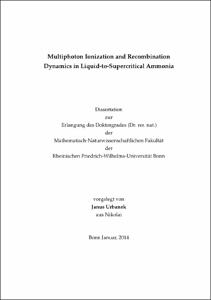Urbanek, Janus: Multiphoton Ionization and Recombination Dynamics in Liquid-to-Supercritical Ammonia. - Bonn, 2014. - Dissertation, Rheinische Friedrich-Wilhelms-Universität Bonn.
Online-Ausgabe in bonndoc: https://nbn-resolving.org/urn:nbn:de:hbz:5n-35727
Online-Ausgabe in bonndoc: https://nbn-resolving.org/urn:nbn:de:hbz:5n-35727
@phdthesis{handle:20.500.11811/6077,
urn: https://nbn-resolving.org/urn:nbn:de:hbz:5n-35727,
author = {{Janus Urbanek}},
title = {Multiphoton Ionization and Recombination Dynamics in Liquid-to-Supercritical Ammonia},
school = {Rheinische Friedrich-Wilhelms-Universität Bonn},
year = 2014,
month = may,
note = {This thesis reports on the first-ever femtosecond transient absorption study of solvated electrons that were produced by multiphoton excitation of neat fluid ammonia. To obtain insight into the ionization mechanism below and above the optical valence-to-conduction band gap of the solvent, the initial ultrafast ionization was carried out with a 400 nm, respectively a 266 nm laser pulse, both of which were found to require two photons corresponding to a total excitation energy of 6.2 eV, respectively 9.3 eV. Subsequently, the solvated electron was monitored with femtosecond probe pulses that was resonant with its characteristic near-infrared absorption band around 1700 nm. A primary goal of the experiments was to explore the role of structural and electronic properties of the solvent network in the photoionization pathways below and above the band-gap. For this purpose, the ammoniated electron’s geminate recombination dynamics was systematically studied over wide ranges of temperature (227 K ≤ T ≤ 489 K) and density (0.17 g/cm3 ≤ ρ ≤ 0.71 g/cm3), thereby covering the dense liquid and the dilute supercritical phase of the solvent. A kinetic analysis of the electron’s survival probability was carried out to determine the temperature and density-dependent average thermalization distance of the solvated electron from its primary ionization site,, which offers insight into the nature of the electronic state of the liquid from which the electron is initially injected.
i) At 9.3 eV total excitation energy, vertical ionization was found to initially produce highly mobile electrons in the conduction band of the liquid which only subsequently become localized by the solvent. A pronounced dependence of on the thermodynamic state variables T, ρ was related to a T, ρ-induced energy level shift of the valence-to-conduction band-gap which gives rise to a variation of the energy initially imparted on the photoejected electron.
ii) A total excitation energy of 6.2 eV is about 2 eV below the optical band-gap band in liquid ammonia, hence, an ionization of the neat fluid requires solvent nuclear rearrangement. The solvated electron’s geminate recombination is strongly accelerated compared to the data at 9.3 eV and indicates that the majority of electrons is injected into suitable trapping sites located between the first and second solvation shell of the initially ionized ammonia molecules. Such configurations can be considered as instantly reactive and facilitate an ultrafast barrierless electron annihilation.},
url = {https://hdl.handle.net/20.500.11811/6077}
}
urn: https://nbn-resolving.org/urn:nbn:de:hbz:5n-35727,
author = {{Janus Urbanek}},
title = {Multiphoton Ionization and Recombination Dynamics in Liquid-to-Supercritical Ammonia},
school = {Rheinische Friedrich-Wilhelms-Universität Bonn},
year = 2014,
month = may,
note = {This thesis reports on the first-ever femtosecond transient absorption study of solvated electrons that were produced by multiphoton excitation of neat fluid ammonia. To obtain insight into the ionization mechanism below and above the optical valence-to-conduction band gap of the solvent, the initial ultrafast ionization was carried out with a 400 nm, respectively a 266 nm laser pulse, both of which were found to require two photons corresponding to a total excitation energy of 6.2 eV, respectively 9.3 eV. Subsequently, the solvated electron was monitored with femtosecond probe pulses that was resonant with its characteristic near-infrared absorption band around 1700 nm. A primary goal of the experiments was to explore the role of structural and electronic properties of the solvent network in the photoionization pathways below and above the band-gap. For this purpose, the ammoniated electron’s geminate recombination dynamics was systematically studied over wide ranges of temperature (227 K ≤ T ≤ 489 K) and density (0.17 g/cm3 ≤ ρ ≤ 0.71 g/cm3), thereby covering the dense liquid and the dilute supercritical phase of the solvent. A kinetic analysis of the electron’s survival probability was carried out to determine the temperature and density-dependent average thermalization distance of the solvated electron from its primary ionization site,
i) At 9.3 eV total excitation energy, vertical ionization was found to initially produce highly mobile electrons in the conduction band of the liquid which only subsequently become localized by the solvent. A pronounced dependence of
ii) A total excitation energy of 6.2 eV is about 2 eV below the optical band-gap band in liquid ammonia, hence, an ionization of the neat fluid requires solvent nuclear rearrangement. The solvated electron’s geminate recombination is strongly accelerated compared to the data at 9.3 eV and indicates that the majority of electrons is injected into suitable trapping sites located between the first and second solvation shell of the initially ionized ammonia molecules. Such configurations can be considered as instantly reactive and facilitate an ultrafast barrierless electron annihilation.},
url = {https://hdl.handle.net/20.500.11811/6077}
}






